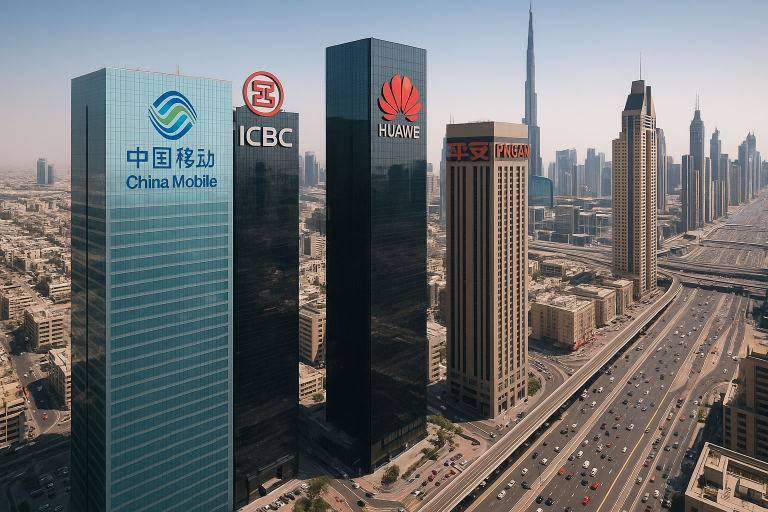Economic Powerhouse Partnership: China-UAE Trade Reaching New Heights
Introduction
In the landscape of 21st-century global trade, few partnerships have demonstrated the explosive growth and strategic importance of the economic relationship between the People’s Republic of China and the United Arab Emirates. Surpassing an incredible $100 billion in bilateral trade in 2024, this economic powerhouse partnership has become a central pillar of the comprehensive strategic alliance between the two nations. This figure is not merely a statistic; it represents a vibrant, multi-layered economic corridor that is fueling growth, driving innovation, and creating shared prosperity. The China-UAE economic relationship is a model of synergy, where China’s immense industrial capacity and consumer market perfectly complement the UAE’s status as a global hub for trade, finance, and logistics. This article delves into the remarkable dimensions of this economic partnership, examining the scale of their bilateral trade, the deepening investment synergies, the diversification into future-oriented sectors, and the shared blueprint for the next decade of economic prosperity.
The Scale of Trade: A Century Billion Dollar Partnership
The sheer volume of trade between China and the UAE is a testament to their deep economic integration. In 2024, the total bilateral trade value reached an impressive $101.838 billion, a figure that has grown exponentially over the past decade [1]. This positions the UAE as China’s second-largest trading partner in the Middle East, while China has solidified its status as the UAE’s largest trading partner globally for several consecutive years. This trade is a two-way street of complementary strengths. China exports a wide array of high-value goods to the UAE, including advanced machinery, electronics, high-tech products, and textiles. In return, the UAE is a crucial energy supplier to China, exporting significant quantities of crude oil and petrochemical products, making it China’s sixth-largest source of crude oil imports.
However, the UAE’s role in this economic narrative extends far beyond being a simple destination market. It functions as a critical gateway and re-export hub. A significant portion of the goods arriving from China at the UAE’s world-class ports, such as Jebel Ali, are subsequently re-exported to markets across the Middle East, Africa, and Europe. This logistical prowess, combined with a business-friendly environment, has made the UAE an indispensable node in China’s global trade network and a vital partner in the Belt and Road Initiative.
China-UAE Bilateral Trade (2024)
Total Trade Volume: $101.838 Billion
Chinese Exports to UAE: $65.593 Billion
Chinese Imports from UAE: $36.245 Billion
Key Chinese Exports: Machinery, Electronics, High-Tech Goods, Textiles
Key UAE Exports: Crude Oil, Petrochemicals.
Investment Synergies: Fueling Mutual Growth
Parallel to the surge in trade, bilateral investment flows have become a powerful engine for growth. The investment relationship is increasingly characterized by a two-way flow into strategic, high-value sectors. Recent years have seen Chinese investment in the UAE grow by a remarkable 16%, while UAE investment in China has soared by an even more impressive 120% [2]. This demonstrates a mutual confidence in each other’s long-term economic prospects.
A cornerstone of this investment partnership is the UAE-China Joint Investment Cooperation Fund. Established in 2015, this $10 billion fund, co-sponsored by Mubadala Investment Company and Chinese state institutions, is a strategic vehicle to deploy capital in sectors of mutual interest. The fund has played a vital role in financing impactful projects in conventional and renewable energy, infrastructure, technology, and more, both within the two countries and in third-party markets. This institutional framework for investment ensures a long-term, strategic approach to capital allocation.
The corporate footprint in each other’s markets is another clear indicator of deepening ties. Over 8,000 Chinese companies have established operations in the UAE, leveraging the country as a regional headquarters to manage their business across the Middle East and Africa. This vibrant community, which includes major state-owned enterprises and innovative private companies, is a driving force behind job creation and technology transfer.
Sectoral Cooperation: Diversifying the Economic Landscape
While energy has long been a foundational element of the economic relationship, both nations have made a concerted effort to diversify their cooperation into a wide range of non-oil sectors. This forward-looking strategy is building a more resilient and future-proof economic partnership.
Technology and Innovation: The UAE and China are emerging as key partners in the digital economy. Joint ventures and collaborations are flourishing in areas like 5G network deployment, artificial intelligence (AI), smart city development, and e-commerce. Chinese tech giants are increasingly choosing the UAE as a base for their regional operations, while Emirati firms are actively seeking Chinese technology and expertise to drive their own digital transformation.
Financial Integration: The financial corridor between the UAE and China is becoming increasingly sophisticated. The establishment of branches of major Chinese banks in the UAE’s financial centers (DIFC and ADGM) has been critical in financing bilateral trade and investment. Furthermore, currency swap agreements have facilitated the use of the Chinese Yuan (RMB) and the UAE Dirham (AED) in trade settlement, reducing transaction costs and risks. The collaboration extends to FinTech and digital currencies, with both central banks participating in initiatives like the mBridge project to explore more efficient cross-border payment solutions.
Future Economic Blueprint: The Next Decade of Prosperity
Looking ahead, the China-UAE economic partnership is guided by a shared vision for sustainable and innovation-driven growth. Both countries have set ambitious targets for increasing trade and investment volumes, but the focus is increasingly on the quality and strategic nature of their cooperation. Emerging opportunities abound in the digital economy, where collaboration can extend to data centers, cloud computing, and cross-border data flows. Green finance is another promising frontier, with both nations poised to lead in the issuance of green bonds and the creation of investment funds dedicated to sustainable infrastructure and renewable energy projects.
In this dynamic environment, the UAE China Chamber of Commerce (UECN) serves as an essential catalyst. It is the primary conduit for businesses seeking to tap into the vast opportunities of this economic corridor. By facilitating business-to-business connections, providing crucial market intelligence, and helping companies navigate the commercial and regulatory landscapes of both countries, the UECN plays an indispensable role in translating the strategic vision of the two governments into tangible business success.
Conclusion: A Model for Global Economic Cooperation
The economic partnership between China and the UAE is a global exemplar of what can be achieved through strategic alignment and a commitment to mutual benefit. It has moved far beyond a simple transactional relationship to become a deeply integrated and synergistic alliance. The pillars of this success are clear: soaring trade volumes, robust two-way investment flows, and a strategic diversification into the industries of the future. This win-win cooperation is not only driving economic growth and creating jobs in both nations but is also enhancing regional connectivity and contributing to the stability of global supply chains. As they build on the success of their first $100 billion in trade, the UAE and China are forging a golden partnership that will continue to set new standards for international economic cooperation in the 21st century.
References
[1] Ministry of Foreign Affairs of the People’s Republic of China. (n.d.). UAE (United Arab Emirates). Retrieved from https://www.fmprc.gov.cn/eng/gjhdq_665435/2675_665437/2903_663806/
[2] WAM. (2025, February 22). Abu Dhabi signs groundbreaking agreements with China. Retrieved from https://www.wam.ae/en/article/bibx7cp-abu-dhabi-signs-groundbreaking-agreements-with







